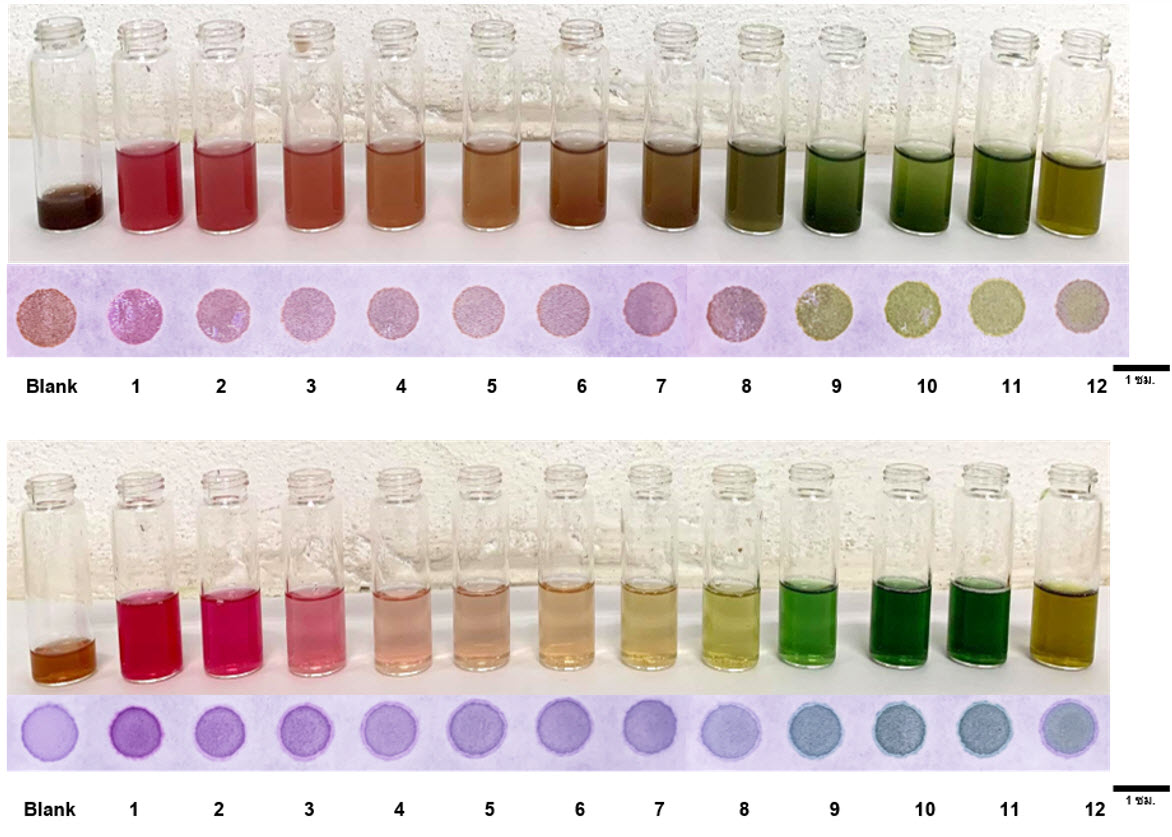การไทเทรตกรด–เบสบนอุปกรณ์ตรวจวิเคราะห์ของไหลจุลภาคฐานกระดาษ (ไมโครแพด) โดยใช้อินดิเคเตอร์ธรรมชาติ
Main Article Content
Abstract
Phattaravan Supalert, Rattapol Meelapsom, Akarapong Prakobkij, Saksri Supasorn and Purim Jarujamrus
รับบทความ: 11 มกราคม 2564; แก้ไขบทความ: 26 มีนาคม 2564; ยอมรับตีพิมพ์: 1 มิถุนายน 2564; ตีพิมพ์ออนไลน์: 4 พฤศจิกายน 2564
บทคัดย่อ
งานวิจัยนี้ได้มีการสร้างอุปกรณ์ตรวจวิเคราะห์ของไหลจุลภาคฐานกระดาษ (ไมโครแพด) ด้วยเทคนิคการพิมพ์สกรีนด้วยไขเพื่อสร้างช่องรองรับการเกิดปฏิกิริยา และใช้ไมโครแพดในการไทเทรตกรด–เบสโดยมีอินดิเคเตอร์ธรรมชาติเป็นแอนโทไซยานินที่สกัดได้จากดอกฟ้าประทานพรโดยอุปกรณ์ที่พัฒนาขึ้นสามารถระบุจุดยุติของการไทเทรตด้วยการสังเกตการเปลี่ยนแปลงสีของ อินดิเคเตอร์ที่เกิดขึ้นด้วยตาเปล่า นอกจากนี้ยังมีการทดสอบความถูกต้องของอุปกรณ์ที่พัฒนาขึ้นโดยการตรวจวัดปริมาณของกรดในตัวอย่างจริง ได้แก่ น้ำยาล้างห้องน้ำ และน้ำส้มสายชู อุปกรณ์การไทเทรตกรด–เบสที่สร้างขึ้นนี้มีจุดเด่นเมื่อเทียบกับวิธีการไทเทรตแบบมาตรฐาน ได้แก่ ต้นทุนต่ำ ใช้สารเคมีน้อยในระดับไมโครลิตร ใช้งานง่าย พกพาสะดวก และสอดคล้องตามหลักการ “เคมีสีเขียว” อีกทั้งยังให้ประสิทธิภาพและผลการทดลองเทียบเท่ากับการไทเทรตกรด–เบสแบบดั้งเดิม นอกจากนี้คาดว่าอุปกรณ์ที่พัฒนาขึ้นสามารถเป็นอุปกรณ์ทางเลือกเพื่อใช้เป็นชุดทดลองในวิชาเคมีในการจัดการเรียนรู้เพื่อความรู้ความเข้าใจในเรื่องการไทเทรต
คำสำคัญ: การไทเทรตกรด-เบส อินดิเคเตอร์ธรรมชาติ อุปกรณ์ตรวจวิเคราะห์ของไหลจุลภาคฐานกระดาษ ไมโครแพด เคมีสีเขียว, ดอกฟ้าประทานพร
Abstract
This study aimed to develop a microfluidic paper–based analytical device (µPAD) which was fabricated by using a wax screen–printing technique for acid-base titration. Anthocyanins extracted from Ruellias tuberosa L. flower was used as a natural indicator for acid–base titration. Our developed method can estimate the endpoint of acid–base titration by observing the color change of the indicator with the naked eye. Furthermore, a real sample application (bathroom cleaner, vinegar) was also investigated to ensure the accuracy of this developed method. This µPAD provides many advantages such as low–cost, low chemical volume (microliter), easy to use, and portable which is following “Green Chemistry” principles. Besides, the performance of this developed method was agreed well with conventional acid-base titration. Besides, this developed device can be used as an experimental kit in a classroom for understanding the concept of titration.
Keywords: Acid–base titration, Natural indicator, Microfluidic paper–based analytical device, µPAD, Green–chemistry, Ruellias tuberosa L. flower
Downloads
Article Details

This work is licensed under a Creative Commons Attribution-NonCommercial 4.0 International License.
References
Byamukama, R., Waninda, E. N., Mukama, D., and Namukobe, J. (2016). Hippeastrum hybridum anthocyanins as indicators of endpoint in acid–base titrations. International Journal of Biological and Chemical Sciences 10(6): 2716–27.
Castañeda–Ovando A., Pacheco–Hernández, M. D. L., Páez–Hernández, M. E., Rodrí-guez, J. A., Galán–Vidal, C. A. (2009). Chemical studies of anthocyanins: A review. Food Chemistry 113: 859–871.
Din–a, A., Tamuang, S., Amatatongchai, M., Jarujamrus, P., and Chairam, S. (2016). Simple, low–cost and small scale titration set for microscale laboratory in classroom. Journal of Research Unit on Science, Technology and Environment for Learning 7(2): 424–436. (in Thai)
Garber, K. C., Odendaal, A. Y., and Carlson, E. E. (2013). Plant pigment identification: A classroom and outreach activity. Journal of Chemical Education 90(6): 755–759.
Gupta, P., Jain, P., and Jain, P. K. (2012). Flower sap: A natural resource as indicator in acidimetry and alkalimetry. International Journal of ChemTech Research 4(4): 1619–1622.
Karita, S., and Kaneta, T. (2014). Acid–base titrations using microfluidic paper–based analytical device. Analytical Chemistry 86(24): 12108–12114.
Kovács, L., Csupor, D., Lente, G., and Gunda, T. (Eds). (2014) 100 Chemical Myths; Misconceptions, Misunderstandings, Explanations. Switzerland: Springer International.
Laleh, G. H., Frydoonfar, H., Heidary, R., Jameei, R., and Zare, S. (2006). The effect of light, temperature, pH and species on stability of anthocyanin pigments in four berberis species. Pakistan Journal of Nutrition 5(1): 90–92.
Lertsuwunpaisal, P., Yoome, P., and Srisopa, A. (2016). Titration technique development based on microscale and the implement in science classes. Humanities and Social Sciences Journal of Graduate School, Pibulsongkram Rajabhat University 10(2): 18–36. (in Thai)
Namwong, P., Jarujamrus, P., Amatatongchai, M., and Chairam, S. (2018). Fabricating simple wax screen–printing paper-based analytical devices to demonstrate the concept of limiting reagent in acid–base reactions. Journal of Chemical Education 95(2): 305–309.
Nogueira, S. A., Sousa, L. R., Silva, N. K. L., Rodrigues, P. H. F., and Coltro, W. K. T. (2017). Monitoring acid–base titrations on wax printed paper microzones using a smartphone. Micromachines 8(5): 139.
Sukaram, T., Sakunrungrit, K., Juanjankarn, J., Siriboon, J., Sirisakwisut, P., Yensamran, Y., Chaneam, S. (2020). Application of natural reagent from orchid flower as indicator for volumetric acid–base titration. Thai Science and Technology Journal 28(9):1545–1557. (in Thai)
Suppadit, T., Sunthorn, N., and Poungsuk, P. (2011). Use of anthocyanin extracted from natural plant materials to develop a pH test kit for measuring effluent from animal farms. African Journal of Biotechnology 10(82): 19109–19118.
Taghizadeh–Behbahani, M., Hemmateenejad, B., and Shamsipur, M. (2018). Colorimetric determination of acidity constant using a paper–based microfuidic analytical device. Chemical Papers 72(5): 1239–1247.
Teprek, A., Artono, V. P., Waiyawat, W., Lim-sakul, A., Shiowatana, J., Siripinyanond, A. (2020) Semi–quantitative analysis by spot counting on origami paper–based device for endpoint detection in titrimetric analysis. Microchemical Journal 158: 105284.
Thongpoon, C., and Kraison, P. (2015). Acid–base titration by using butterfly pea extract as indicator. Rajabhat Journal of Sciences, Humanities and Social Sciences 16(2): 156–66. (in Thai)
Vankar, P. S., and Bajpai D. (2010). Rose anthocyanins as acid base indicators. Electronic Journal of Environmental, Agricultural and Food Chemistry 9(5): 875–84.
Wongchuphan, R., Choonim, K., and Thongpoon, C. (2016). Colored plants used as natural indicators. Rajabhat Journal of Sciences, Humanities and Social Sciences. 17(1): 74–83. (in Thai)
